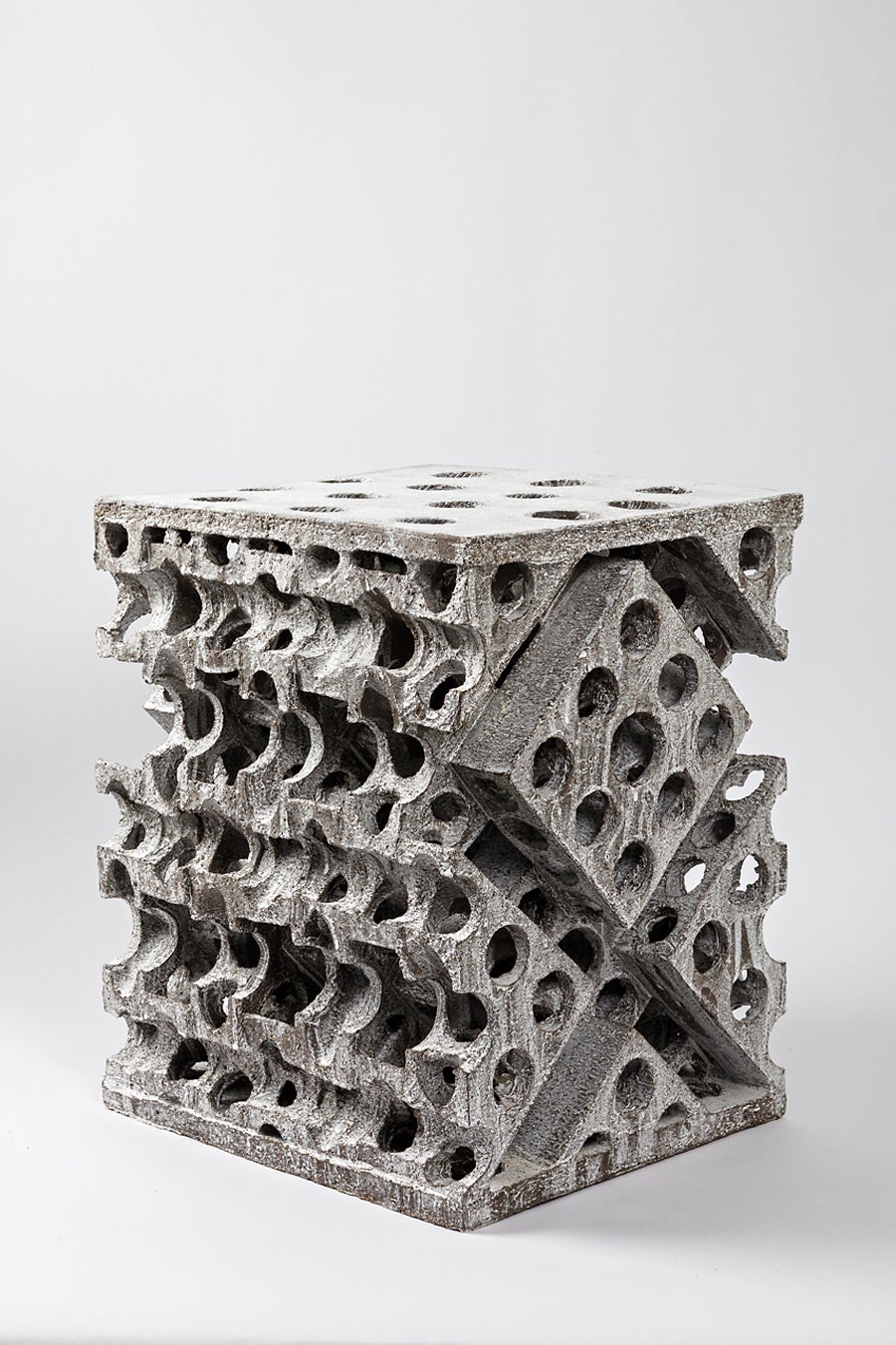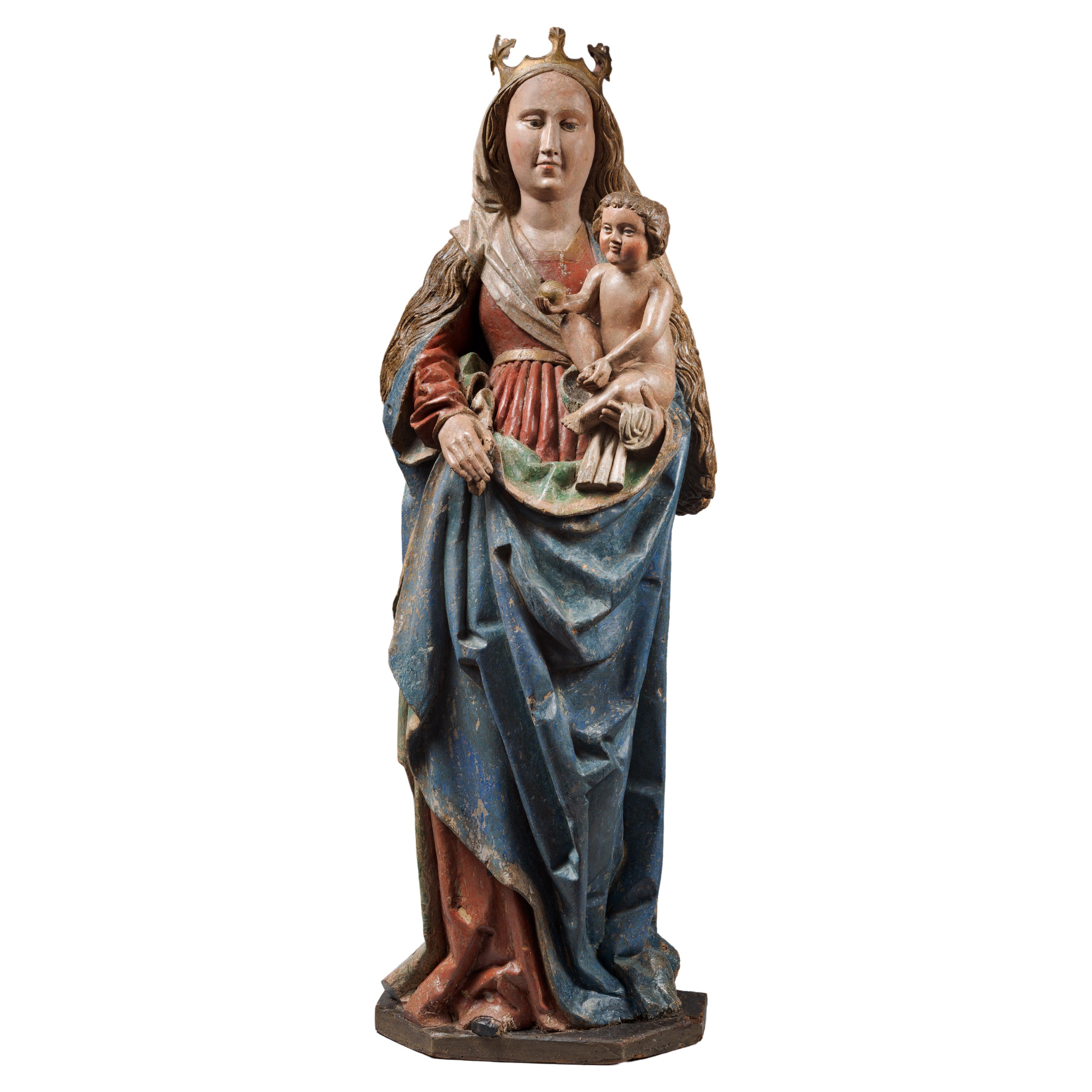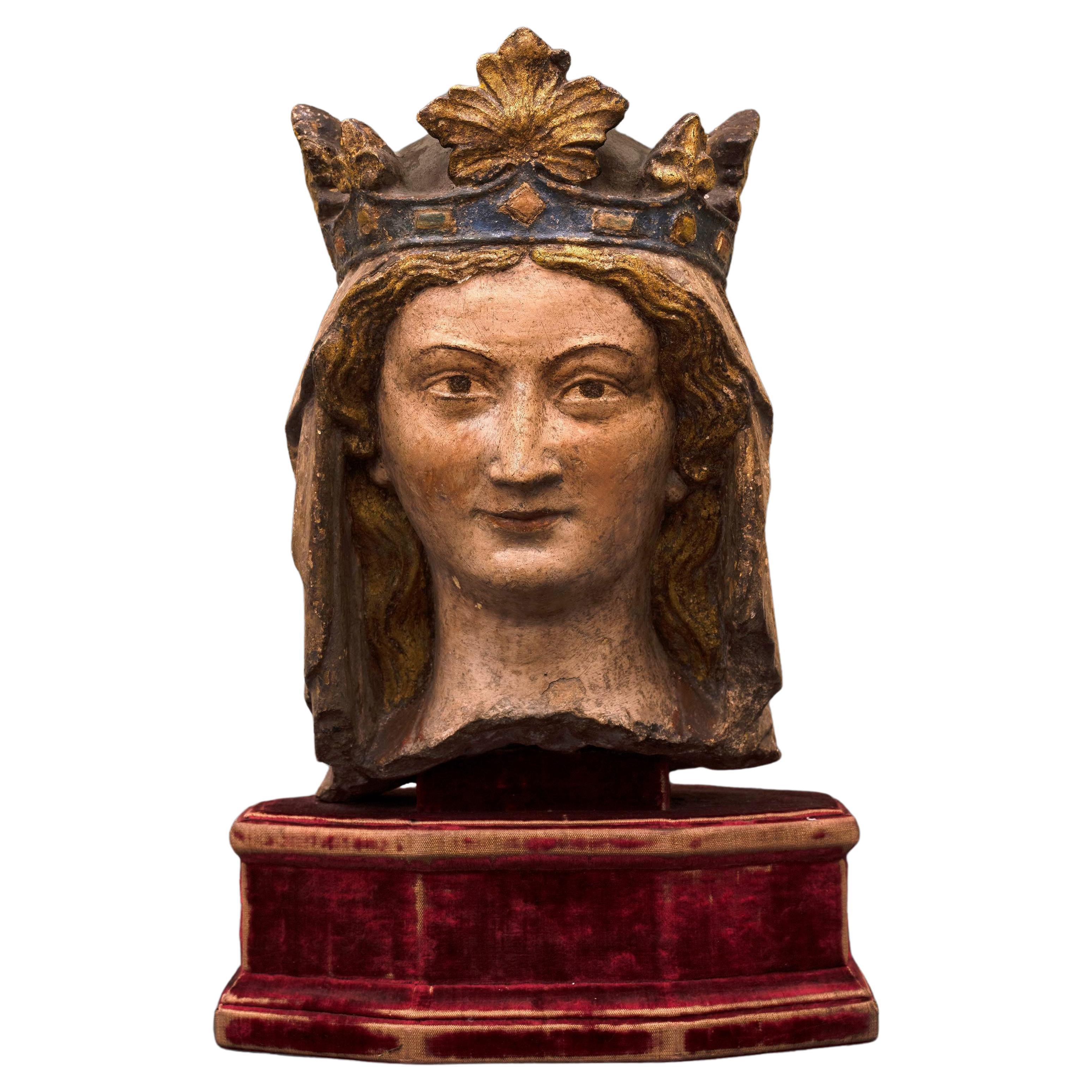Items Similar to Important 14th Century Polychrome Limestone Virgin from Lorraine
Want more images or videos?
Request additional images or videos from the seller
1 of 5
Important 14th Century Polychrome Limestone Virgin from Lorraine
About the Item
Provenance :
- Kunsthaus Heinrich Hahn, Frankfurt am Main, sale 16, June 17, 1930, lot 16.
- Sotheby's, Amsterdam, Feb. 26, 2006, lot 201.
HISTORIC
Located between Moselle valley and Meuse valley, framed by the Vosges Mountains on the south side and the duchy of Luxembourg on the north side, the duchy of Lorraine is the result of several partitions. It starts with the 9th century when the Carolingian empire is divided, with Lothar 1st inheriting Lotharingia. In 959 this territory was in turn divided in two; Lower and Upper Lotharingia, the latter being the forebear of the duchy of Lorraine. This duchy was under the rule of the Holy Roman Germanic Empire until 1736 when it was absorbed by the kingdom of France.
All along its history the duchy of Lorraine has found itself in the midst of many conflicts. Alliances and feuds marking European history were always particularly sensible in Lorraine where instability was frequent. Because of its geographic position the duchy of Lorraine was also an artistic crossroad.
Hence the duchy of Lorraine becomes from the 13th century onwards an important artistic centre where a particular type of Virgin and Child appears. According to professor J. A. Schmoll the characteristics of Lorraine sculpture burgeon around 1280-1300 in the Aube region. It presents “vigorous volumes, restrained movements, rare but solemn gestures and a strong interiorised and stern expression”. Those Virgins look similar with a wide forehead, a shield- or oval-shaped face, large neck, small lips and a cleft chin.
This model is particularly in favour during the 13th century because of the revival for Marial worship and for the theme of the Virgin and Child. It bears witness to a new religious sensibility with a more intimate vision of religious practice.
DESCRIPTION
The important 14th century Virgin we present to you is one of the most beautiful examples of sculptural art from Eastern France, with her fascinating distant gaze.
Her contrapposto posture is induced by the weight of the child she carries high on her left side. The child has a chubby face framed by blond hair with well defined curls and he wears a long red V-collared tunic from which emerge his feet. The fabric is animated by long folds. The position of the right foot turned to the back is a detail we can notice on several Virgins from Lorraine. He holds a bird that seems to be pecking his thumb.
“The bird /held by the child in his hands/ has been read as a reference to an episode from Christ’s childhood when he has moulded sparrows with clay before giving them life. It appears in the apocryphal gospel of Pseudo-Matthew (ch. 27) and later in the Quran (III, 43, v. 110). However the iconography seems to be more influenced by the concept of Redemption or of Eucharist, the bird symbolising the soul of the Christian about to be redeemed or revitalised.”
Mary wears a long dress with two rock crystal cabochons remaining from the original five. She is covered by a red cloak enriched with old-gold motifs draped as an apron falling in long pleats along her left hip. The relief treatment and the volume of the cloak developing a network of concentric pleats contrast with the the flat pleating of her dress. They nevertheless suggest the curve of her bent right leg.
She wears a floret crown securing a short thin veil carved in very low relief. From it emerges her blond curled hair characteristic of the 13th century. The large face with almond-shaped eyes, straight nose, small lips and cleft chin casts its gaze afar in a fashion typical of 13th century Virgins.
In her right hand she holds a lily flower. In a very refined manner the artist has carved a band on her right ring-finger.
In the back, carefully sculpted, spreads the minutely detailed short veil.
COMPARATIVE STUDIES
This sculpture of great quality presents obvious similarities with Virgins from Lorraine, designated by William Forsythe as the group of Saint Dié (Vosges region) in an article from 1936. He gathers those Virgins around the one group in particular, made for the cloister of Saint-Dié cathedral. Additionally to this Virgin we can also compare the Virgin and Child we present here to two other sculptures belonging to a same group; the Virgin and Child from the church of Sion monastery (Meurthe-et-Moselle region) as well as the one in the provincial museum of Trier.
Indeed those Virgins all present:
- A strong stature
- A contrapposto induced by the weight of the child
- The right knee bent
- A long oblique pleat going from below her left arm to the right foot
Thus, according to this article our Virgin and Child was undoubtedly made by a brilliant artist working in the heart of the Lorraine region.
Literature
- J.A.SCHMOLL gene. Eisenwerth, Die Lothringische Skultur des 14. Jarhunderts, Michael Imhof Verlg, D-36100 Petersberg, 2005.
-
- William FORSYTHE, Medieval statues of the Virgin in Lorraine related in type to the St Dié Virgin, Metropolitan museum studies, 1936.
- Dimensions:Height: 44.89 in (114 cm)Width: 18.9 in (48 cm)Depth: 15.75 in (40 cm)
- Style:Gothic (Of the Period)
- Materials and Techniques:
- Place of Origin:
- Period:
- Date of Manufacture:circa 1330
- Condition:Minor fading.
- Seller Location:Saint-Ouen, FR
- Reference Number:1stDibs: LU3115327315932

About the Seller
5.0
Vetted Seller
These experienced sellers undergo a comprehensive evaluation by our team of in-house experts.
Established in 2016
1stDibs seller since 2017
158 sales on 1stDibs
Typical response time: 8 hours
- ShippingRetrieving quote...Ships From: Saint-Ouen, France
- Return PolicyThis item cannot be returned.
More From This SellerView All
- Important German Pietà from the, 14th CenturyLocated in Saint-Ouen, FRIMPORTANT GERMAN PIETÀ FROM THE 14th CENTURY ORIGIN: GERMANY, REGION DE COLOGNE PERIOD: BEGINNING IF THE 14th CENTURY, ca. 1330 Height: 98 cm Length: 45 cm Depth: 33 cm Polychromed linden wood Good condition of conservation Provenance : particular Alsatian collection The theme of the Pietà or Vesperbild appears in Germany at the end of the 13th century, reflecting the mysticism of the late Middle Ages. Although the theme does not exist in the Gospels, it was often mentioned in contemporary devotional literature. Indeed, during the first half of the 14th century, mystical thought and devotional practices changed under the impulse of a number of religious, among them Heinrich Suso and St Bridget. In his writings, Suso placed important emphasis on contemplation and meditation in the footsteps of Christ's martyrdom. This will have great impact in the field of art, especially in Germany and later in France. The emphasis will from now on be on grief, death is shown in a straightforward way. The wounds of Christ are gaping and bloody. The suffering of Christ and the seven sorrows of the Virgin Mary are meditated upon. This piece demonstrates the interest of the faithful in these representations where pathos reigns. The virgin is represented seated in a frontal position. The bust is very elongated. She is wearing a red dress with a simple neckline and a blue mantel...Category
Antique 15th Century and Earlier Figurative Sculptures
MaterialsWood
- Polychrome carved wood Virgin and Child from the 15th CenturyLocated in Saint-Ouen, FRPOLYCHROME CARVED WOOD VIRGIN AND CHILD FROM THE 15TH CENTURY ORIGIN: SOUTH GERMANY, SWABIA, NUREMBERG REGION PERIOD: 15th CENTURY Height: 94,6cm Width : 28 cm Depth : 18 cm Lime wood Original Polychromy Good state of conservation From 1430 onwards, sculpture underwent a profound stylistic renewal which continued until 1530, the so-called late Gothic period. In the Germanic countries, original sculptures flourished in an expressive and sensitive vein. This renewal was inspired by the art of Nicholas of Leiden, who was active in Strasbourg in the 1460's. His style broke with the refined and delicate art of the international Gothic style in force throughout Europe around 1400. The figures became more authentic and realistic. The bodies became denser. Clothes are animated by deep, broken folds, the fabrics are heavy and have a great decorative value. In addition, the polychromy is intended to be illusionistic. The painting makes it possible to restore the texture of the materials, the richness of the textiles and the natural skin tone of the characters. The dissemination of images through engraving and the great mobility of the artists led to the success of this style, which conquered the Upper Rhine, Swabian, Tyrolean and Franconian regions, contributing to the formation of a common stylistic identity in these regions. The economic boom in the flourishing German cities was conducive to the development of original production. Attracted by this prosperity, numerous workshops were set up in order to meet the orders of religious communities, the Church and the laity, including a clientele of middle-class rockers. This precious Virgin and Child is depicted standing on a crescent moon, her head encircled by a crown of tall flowers. Her long wavy hair spreads over her shoulders, framing her beautiful oval face. Under fine eyebrows drawn with a brushstroke, her almond-shaped, slightly drooping eyes look at the Child with infinite softness. She is dressed in a long red dress with a rounded neckline, belted under the chest. The heavy fabric of her dress spreads out in broken folds at her feet. On her shoulders she wears a golden cloak. The drapery has deep folds. She holds out her right hand while she holds the Christ Child with her left. Christ, with his well-defined hair, is naked. His cheeks are highlighted with red, he holds an apple in his left hand and with the other hand makes a sign of blessing towards the faithful. Virgins with Child on a crescent moon were very popular in the second half of the 15th century, especially as the central subject of altarpieces in southern Germany and Austria. The crescent moon on which Mary is standing is reminiscent of the Woman of the Apocalypse. Often equated with the Virgin Mary. This episode is taken from the Book of Revelation (12:1-6) 1 Then a great sign appeared in heaven: a woman clothed with the sun, with the moon under her feet and a crown of twelve stars on her head. ; 2 She was pregnant, and she cried out because she was in labor, in pain from giving birth. ; 3 Then another sign appeared in heaven: it was a great fiery red dragon, with seven heads and ten horns, and seven royal crowns on his heads. ; 4 His tail swept down a third of heaven's stars and threw them to the earth. The dragon stood in front of the woman who was about to give birth so that when she gave birth, he might devour her child. ; 5 She gave birth to a son, a male child who is to rule all the nations with an iron rod. Her child was snatched up to God and his throne. ; 6 Then the woman fled into the desert, where God has prepared a place for her. There she will be taken care of for one thousand two hundred sixty days. Some theologians see in this woman a reference to the Virgin Mary and in the child, Jesus. This remarkable work is a very fine example of sculpture from Swabian workshops in the last decades of the 15th century. It presents all the characteristic stylistic elements: a highly girdled silhouette, an abundant drapery with angular folds, but also a great physical presence accentuated by the polychromy that restores the anatomical details. This group is made of a wooden log. The deep folds of the drapery highlight the movement of the Virgin holding the child. Bibliography : Sophie Guillot de Suduiraut, Dévotion et Séduction, Sculptures souabes des musées de France, vers 1460-1530, Paris musée du Louvre-Éditions somogy, 2015 “Revelation 12 - Common English Bible...Category
Antique 15th Century and Earlier German Gothic Figurative Sculptures
MaterialsWood
- Important 15th Century Polychrome Wood Virgin and ChildLocated in Saint-Ouen, FRImportant 15th century polychrome wood virgin and child Origin: Southern Germany Period: Late 15th Century, Ca. 1480-1490 Height : 125 cm Polychrome limewood Good condition Provenance : Private collection, Alsace, France. As soon as 1430, sculpture starts a major and deep stylistic evolution than will unfold over a century, until around 1530. We call it the International Gothic. This production is particularly interested in a quest for realism. This important Virgin and Child wears a long red dress with a round gilded neckline. A delicate golden belt...Category
Antique 15th Century and Earlier Figurative Sculptures
MaterialsWood
- 13th Century Virgin and Child from CataloniaLocated in Saint-Ouen, FRSeating on a bench-like throne the Virgin carries her child on her left knee. She bears an important crown high on her head .The Virgin has an ovoid face with bulging eyes, straight long nose and thin lips. The hair parts in the middle and are carved as thick horizontals parallel hair strands...Category
Antique 15th Century and Earlier Spanish Gothic Figurative Sculptures
MaterialsOak
- 14th Century Sculpture of the Head of an Angel from East of France or RhinelandLocated in Saint-Ouen, FRThis face with prominent eyes, open mouth and beautiful hairs with symetrical undulations may be the face of the Archangel Gabriel.Category
Antique 15th Century and Earlier French Gothic Figurative Sculptures
MaterialsWood
- Gothic Virgin and Child from FlandersLocated in Saint-Ouen, FRExhibition Museum Cantini, 1952, The art of the Middle Ages in the Marseille collections, n°101 Provenance Former collection Louis Bresset (before 1952) Former collection Profe...Category
Antique 15th Century and Earlier Dutch Gothic Figurative Sculptures
MaterialsOak
You May Also Like
- Gothic crowned Head - Île de France, 14th centuryLocated in Bruxelles, BEHead of a crowned Virgin Île-de-France, first half of 14th century. H26 x 14 x 14 cm Provenance : - Private Collection, Paris France (1960) - Private Collection Tuscany, Italy (19...Category
Antique 15th Century and Earlier French Gothic Figurative Sculptures
MaterialsStone
- Alabaster high relief, Spain 14th centuryLocated in PARIS, FRAlabaster plate in high relief illustrating a forgeron working on a metal object (a helmet?). A young woman is in front of him holding in her left hand an ovoid vase or reliquary tha...Category
Antique 15th Century and Earlier Spanish Medieval Figurative Sculptures
MaterialsAlabaster
- 18th Century North Spanish Polychrome Wooden Virgin SculptureLocated in Marbella, ES18th Century north Spanish polychrome wooden sculpture of the Virgin Mary holding baby Jesus.Category
Antique Late 18th Century Spanish Figurative Sculptures
MaterialsWood
- 16th Century French Oak Polychrome Statue of Saint MaudezLocated in San Francisco, CA16th century French oak polychrome statue of Saint Maudez. A Breton saint from the 5th-6th century who founded a monastery off the coast of Brittany. Saint Maudez was said to have ba...Category
Antique 16th Century French Gothic Figurative Sculptures
MaterialsGesso, Oak
- Set of Three 14th or 15th Century Ceramic Fertility Figures from ThailandLocated in Yonkers, NYA set of three Thai ceramic fertility figures from the 14th or 15th century. Created in Thailand during the 14th or 15th century, this set of petite ...Category
Antique 15th Century and Earlier Thai Sculptures and Carvings
MaterialsCeramic
- 18th Century Italian Carved Wood Polychrome Virgin Mary SculptureLocated in Doha, QAThis is an outstanding Italian 18th century carved wood polychromed sculpture of Virgin Mary. The Sculpture is hand painted with some remains of a gold gilt in few places and originated until lately in a private Villa in Tuscany (Italy). The colors are typical red, blue and green are spectacular on this large figure. The Virgin's hands are joined together in a prayer, while standing on a pedestal on the both sides of which are devil's horns (bottom left side horn missing ) symbolising Holly Mary defeating the Evil, protected by the Holly Ghost and an Angel. A story tells the pose of the Virgin Mary sculpture...Category
Antique 18th Century Italian Baroque Figurative Sculptures
MaterialsWood, Pine





